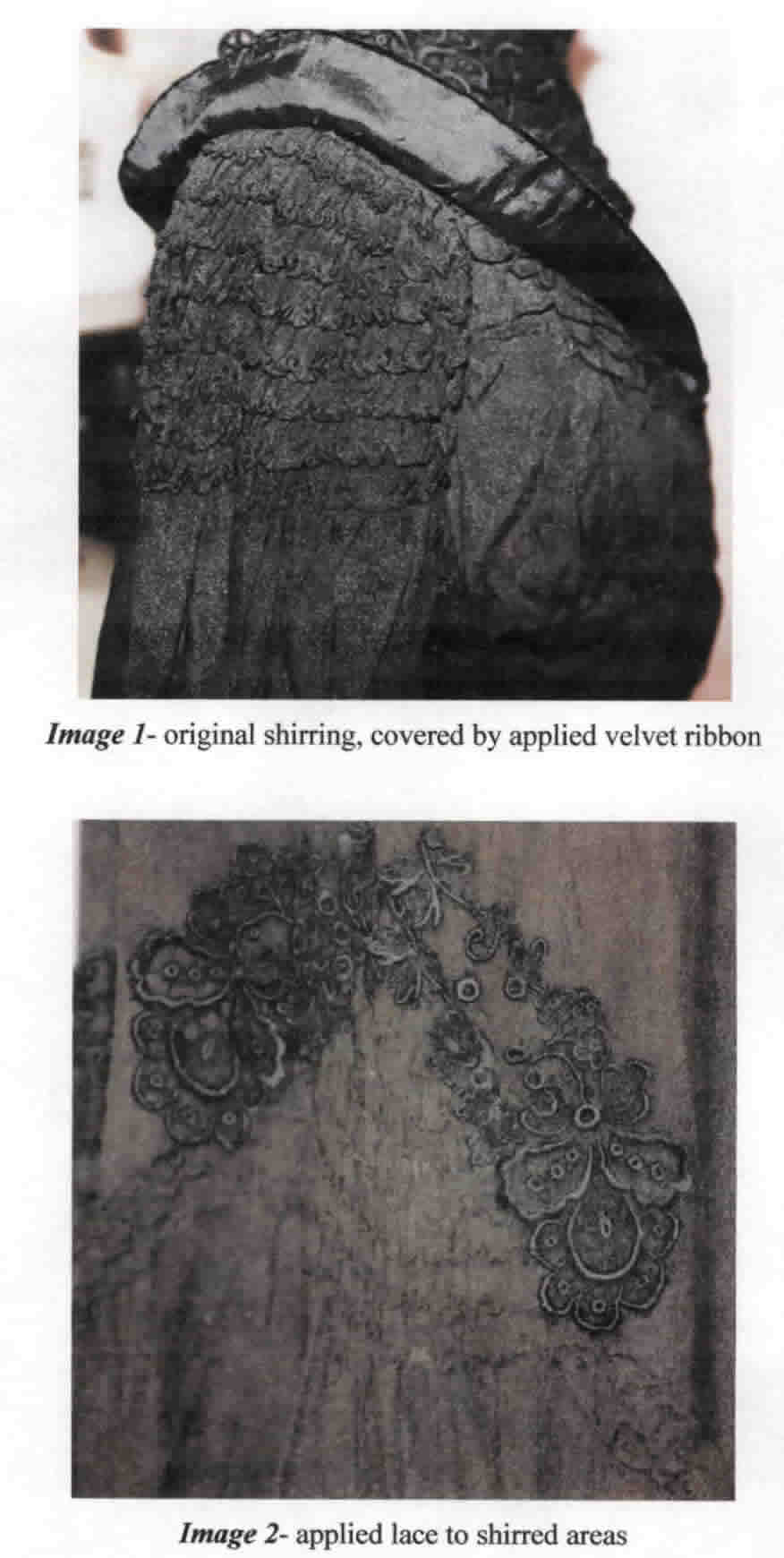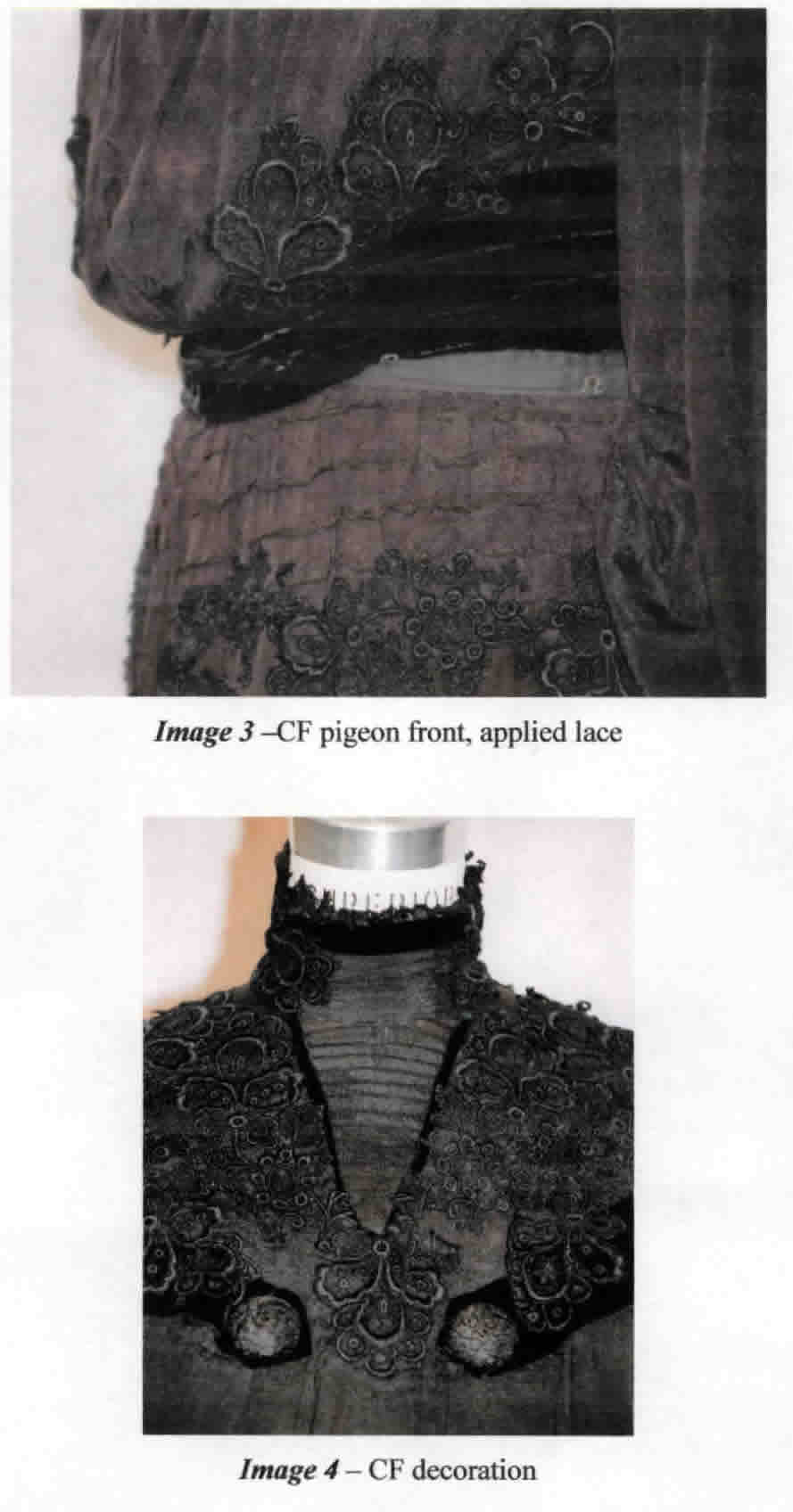The bodice is dated approximately 1902-07. In dating this garment I have looked into contemporary patterning sources in books including those by Janet Arnold and Jean Hunnisett, as well as old Delineator and Harper's Bazar magazines. It is hard to pinpoint an exact year, because in my research I found examples similar to this bodice, and particularly the sleeve style, in all five years I researched. I do think it is earlier rather than later in this time span, as the blouses did look more simple and streamlined as the period progressed, and this particular piece is anything but with it's tucks and frills.
Overview
Initially made of black china silk, silk georgette, and velvet the garment has been altered with applique and velvet ribbon applied to both the bodice and the corresponding skirt. At one point the skirt was enlarged, possibly for stage wear. The additions are not sewn in the same careful manner of the initial garment and cover much of the original pin tucks and shirring that was originally used as decoration (See image 1 below). The appliques are hand stitched in a haphazard manner through all layers with little concern for the garment' s inside appearance. However, they are not in much better condition than the base garment, suggesting that the additions were attached not much longer after the garment was initially made (See image 2 below).
 |
 |
Pieces of padding have been sewn into the inner bodice to insure it's pigeon-front shape. A small padded circle with a diameter of 2.5" and with of .5" has been sewn into the center front; This insures that there is no dip in between the breasts, creating a mono-bosomed shape. Also, there are half-moon shaped pads along each armhole, extending the shape of the bosom on each side. This creates a very wide bosom and creates a larger ledge for the drape of the chiffon to fall from at center front, adding to the pigeon-breasted shape.
The initial seams of the inner bodice were machine stitched and then pinked. The outer georgette layer was flat-lined to the china silk at the shoulder seams but the inner bodice and outer georgette layer are sewn separately at the side seams. Another interesting observation is that almost all the outer layer (georgette) seams are on the straight grain; this is something I realized was extremely practical once I starting reproducing the garment because it is almost impossible to maintain even shirred tucks when working with any sort of bias grain on georgette. Center front and center back are both straight, as is the front side seam.
Being a pigeon-breasted shape, center front is quite full and hangs approximately 1.5" over the center front waistband (See image 3 above). Center front is cut in one piece and is on straight grain. The fullness is controlled over the breasts with 1/8" pin tucks/shirring, coming from the armholes and dipping at center front. A v-shaped insertion has been placed at center front consisting of continuous 1/8" tucks and appears to have been part of the original garment (See image 4 above). However, the velvet ribbon bordering it has not aged as the velvet at the waistband or sleeve cuffs have, and I suspect that it was added when the other trim was. The side seams are placed in the same area as the inner bodice - and the front is hand stitched over the back piece at the side seam, the seam then being lost in the fullness of the shirring at the front. The back chiffon piece is not as full as the front, and is nearly flat under the arm and approaching the side seam. As with the inner bodice, the back is unnaturally high, the bottom of the waistband at center back is approximately 1" above the natural waistline, and the top of the waistband is at the natural waistline at center front. The neck is a closely fitted, 1.75" stand collar, also in continuous 1/8" chiffon tucks. It is finished with a 2" wide black lace, however only 1/2" of the lace is seen from the right side of the collar.
The sleeve is by far the most decorative part of this bodice. After looking through research books, I have approximated the shape of the inner sleeve and drafted it in accordance with the measurements of the garment. The outer sleeve is a beautiful black silk georgette. Eight rows of 1/8" pin tucked-shirring control the fullness at the cap. While there is no height in the cap there is a great deal of fullness in the top of the outer chiffon sleeve. The top of the sleeve is in two pieces, with the front of the sleeve having both seams on straight grain and being nearly 30 inches in width. The back part of the sleeve is not nearly as wide and the tucks in the top of the underarm have been taken but no excess width has been shirred into them. Four flat tucks control the fullness at the elbow in the front of the sleeve, and one row of shirring controls the bottom of the top sleeve, which is quite voluminous. This row of shirring laps onto the fitted bottom of the sleeve, which also has 9 1/8" flat tucks 1.5" from the tuck that attaches it to the upper sleeve, and then 2.5" to the bottom. The cuff is finished with a 7/8" velvet ribbon and the same lace that can be seen at the collar.
Damage
The outside condition of the garment is fair. The outer bodice, made from black georgette is becoming brittle and has one tear vertically along the left side of the bust. As with most vintage garments there is significant discoloring under the arms. The outer sleeves are in remarkably good shape although the inner sleeve is not. It was most likely at one point china silk, but has been patched numerous times with a variety of fabrics and has deteriorated to shreds. The inside of the garment is quickly deteriorating. The china silk was long ago patched with a black cotton fabric, although not symmetrically.
Due to the extremely fragile nature of the inner bodice, pins were carefully placed and measurements were taken and transferred to a grid to develop an approximate pattern. The intake of the vertical dart off of center front was determined once an initial pattern had been developed, enlarged, and then draped on a corresponding form.
© Sara Ausberger Stockton, 2004

